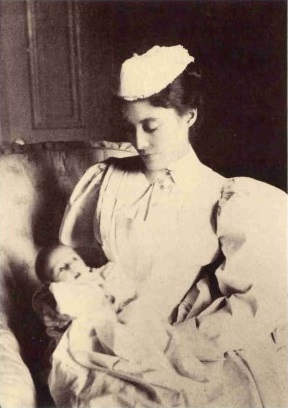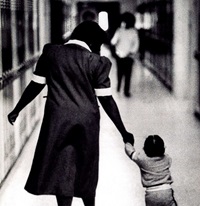UM Children's Hospital History

The University of Maryland Children's Hospital (UMCH), as we know it today, has evolved slowly over time.
Below is a timeline, chronicling some of the events that have shaped UMCH.
- 1873 - The state of Maryland appropriated $30,000 to build a new Greene Street wing onto what was then known as the Baltimore Infirmary. A department of Diseases of Children (the Children's Department) and the Lying-in Department (Department of Obstetrics) was established in the new wing.
- 1916 - John Ruhrah, MD, joins the faculty at the University of Maryland School of Medicine. Ruhrah enjoyed an international reputation as a pediatric scholar after he wrote a beautifully illustrated and popular book called The History of Pediatrics. Ruhrah was also a close friend of President Franklin D. Roosevelt. Like Roosevelt, he suffered from polio. In 1927, he helped the President to establish the Warm Springs Poliomyelitis Foundation in Warm Springs, Georgia – the country's first organization dedicated to fighting polio.
- 1918 - Charles Summers, MD, becomes the first Chief of Pediatrics at University Hospital. Pediatrics was then still a part of the Department of Medicine, and the notion of children being treated any differently than adults was still not widely accepted. Summers ran a large, outpatient clinic and saw many pediatric patients there. He devoted his life to caring for underprivileged children after losing his only child.
- 1925 - Samuel Shipley Glick, MD, graduates from the University of Maryland School of Medicine and begins his pediatrics training with Abraham Finkelstein, MD at the University of Maryland's outpatient department. Glick enjoyed a 40-year career at the University of Maryland that included tenure as associate professor of pediatrics.
- 1934 - The new University Hospital Building on Greene Street opens its doors to patients. The pediatric wards are housed on the fifth floor.
- 1934 - Edmund J. Bradley, MD, joins the medical residency program at the University of Maryland.
- 1948 - Bradley agrees to become the first full-time Chief of Pediatrics on the condition that Pediatrics is allowed to break away from the Department of Medicine and become its own autonomous department. Bradley also insists that improvements and upgrades be made to the new department's facilities.
- 1948 - Pediatrics gains its independence from the Department of Medicine and becomes its own separate department. It was at this time that the care of children became a specialty in its own right with its own disciplines.
- 1948 - One of the first things Bradley does as the head of the new Department of Pediatrics is to desegregate the pediatric wards. Despite resistance from some patients and staff members, Bradley forges ahead. For the first time in the hospital's history, children of all races were treated together in the same facilities. It is interesting to note that University Hospital's pediatric wards were desegregated nearly 20 years before the Civil Rights Act of 1964 ended legal racial segregation in the United States.
- 1949 - Bradley gets a lot of media attention for a study he conducts on epidemic viral vomiting. He found that the pH in Coca-Cola syrup decreased stomach contractions. Articles about his study appear in the Ladies Home Journal, the Wall Street Journal and many other publications.
- 1956 - Bradley publishes a study that found that children in low-income, inner-city neighborhoods had abnormally high rates of lead poisoning. The study encouraged public health officials to test children living in these areas since cases of lead poisoning can be asymptomatic. This study led to others about managing lead poisoning in metropolitan areas and treating it with Ca EDTA.
- 1964 - Bradley's teaching and training program for interns and residents is rated one of the top five in the nation by the American Medical Association.
- 1968 - Marvin Cornblath, MD, takes over as head of the Department of Pediatrics. Under his leadership, the department grows significantly. Within the first year of his tenure, the department balloons from having six or seven residents to about 36 residents.
- 1969 - The Department of Pediatrics really begins to mature and come into its own. Cornblath saw to it that the specialties of oncology, hematology, cardiology, neurology and psychology are incorporated into the department. It was also during this time that the department begins a neonatal transport program, where babies from counties throughout the state are flown by helicopter to the department's neonatal intensive care unit.
- 1970 - The old University Hospital Building, which was constructed in 1824, is torn down. The old building, which was located on Lombard and Greene Streets, had housed the pediatric outpatient department and pediatric emergency room. They are moved to the fifth floor of the new University Hospital Building on Greene Street.
- 1970 - Felix Heald, MD, founds the Division of Adolescent Medicine in July of this year.
- 1974 - Myron Levine, MD, and Richard Hornick, MD, establish the Clinical Research Center for Vaccine Development. In 1976, because of its rapid growth and expansion, the Clinical Research Center becomes the Center for Vaccine Development (CVD). Over the years, the CVD has developed into an international leader in vaccine research for children and adults with infectious diseases.
- 1976 - Michael Berman, MD, joins the Department of Pediatrics as director of pediatric cardiology. Berman had already gained notoriety before coming to Maryland for a device he'd developed as director of Yale University's cardiac catheterization lab called the Berman Angiographic Catheter. Today, the Berman Catheter is used at hospitals around the world to diagnose cardiac problems in pediatric patients.
- 1977 - The University of Maryland begins one of the country's first primary care residency programs. With its focus on internal medicine, pediatrics and nursing, the program establishes the University of Maryland as a leader in primary health care.
- 1977 - The state's first neonatal intensive care unit (NICU) was created. Its remodel in 2015 makes it the largest level 4 NICU in Maryland.
- 1984 - Berman takes over as head of the Department of Pediatrics. During his tenure, the department focuses on further developing pediatric specialties such as behavioral and developmental pediatrics and adolescent pediatrics.
- 1984 - The Department of Pediatrics and the School of Nursing collaborate with the Maryland Department of Health and Mental Hygiene and the March of Dimes to train nurses in the follow-up care of high-risk infants. As a result, about 400 nurses throughout the state were trained to care for infants with complications.
- 1984 - The Pediatric Intensive Care Unit (PICU) is established with an emphasis on clinical research. The Department of Pediatrics becomes recognized as a national leader in medical training and tertiary care. Community hospitals know that they can send difficult cases to the Medical Center because of our expertise and resources.
- 1987 - The pediatric emergency room moves to the first floor of the Medical Center from the fifth floor.
- 1999 - Jay Perman, MD, a distinguished specialist in pediatric gastroenterology, is named professor and chairman of the Department of Pediatrics at the School of Medicine, and Chief of Pediatrics at UMCH. Perman came to the University of Maryland from the Medical College of Virginia in Richmond, where he was chairman of pediatrics and medical director of the Children's Medical Center.
- 2000 - Researchers, led by the UMCH's Alessio Fasano, MD, learn more about the nature of an autoimmune disorder called celiac disease. Their findings, which were published in the medical journal The Lancet, suggest that high levels of zonulin may contribute to celiac disease.
- 2001 - After having briefly been merged with the Department of General Pediatrics, the Division of Adolescent and Young Adult Medicine, which serves about 6,000 young people in the Baltimore area, becomes recognized as a fully established academic division with students training in adolescent care. Community outreach, preventive care and outstanding tertiary services are hallmarks of the division.
- 2011 - The pediatric Extracorporeal Membrane Oxygenation, or ECMO, program was established. ECMO is a machine to remove carbon dioxide from the blood and circulate oxygen throughout the body when a person's lungs cannot function on their own.
- 2011 - The Epilepsy Monitoring Unit was opened.
- 2012 - The Children's Heart Program opened its doors.
- 2016 - STEM cells are used in a pediatric patient for the first time in Maryland.
- 2016 - The Proton Center saw its first pediatric patient.
- 2018 - The Children's Hospital ranked for the first time as a Best Children's Hospital for cardiology and heart surgery by U.S. New & World Report.
- 2019 - The first heart and lung transplant was performed in a pediatric patient in Maryland.
- 2022 - The Children's Hospital celebrated 5 years in a row on the U.S. News Best Children's Hospitals list for cardiology and heart surgery.
- 2023 - University of Maryland Children's Hospital commemorates 75 years of serving Maryland's children.

*Photograph from Historical Collections, Health Sciences and Human Services Library, University of Maryland, Baltimore.
